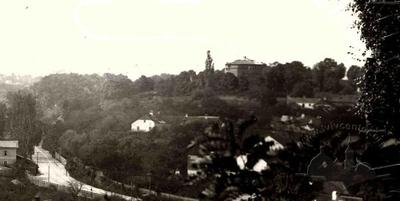Vul. Hrabovskoho – Minor Maximillian Tower No. 3 ID: 40
This is a double-level casemate artillery tower with a cellar and a flat terrace. Planned as a regular nonagon with a round stem with stairs in the central axis. Built of unplastered red brick by an unknown architect in 1854 up on Pelchynska Hill. The tower's chief function was defense of the Citadel's southern wing and main escape gate, located in the fortress' southern bulwarks. This tower has suffered the greatest ruins of all the towers of the Citadel. Because of large breeches and cracks in the walls, the architectural structure of the tower is clearly evident. The tower is in ruins to this day.
Story
Around 1854: construction of the Maximillian Tower No. 3 began around 1850. Architect unknown. Construction was approved by the Central Committee for Defense Construction in Vienna. 150 000 Austrian guilders were allocated for construction of the whole complex. According to an inscription on a stone on the tower's portal, construction was completed in 1854.Beginning in the 1870s, the use of new rifled artillery in combat created a threat for contemporary city fortifications, as well as for all guard camps or polygonal system-type fortifications. Because of this, construction began of dispersed forts, moved out into the foreground. The next step after this was construction of new fortifications in a 4 kilometer radius around Lviv, which began in 1875. These no longer exist today. Tent-type coverings were added to the Maximillian Tower No. 3, as well as the other towers, due to the fact that the Citadel switched to close-range defense and artillery was moved to external forts.
As of 2008, the tower is in ruins and is dangerous to visit.
Architecture
The fort was connected with the court of the Citadel by way of a wooden drawbridge extended over the fort's dry ditch. When drawn up, the body of the bridge covered the gateway of the main entrance, while a cistern of water located under the bridge presented an additional obstacle.In the construction plans, the tower presents a nonagon with vertical walls of unplastered red brick. Spatially the tower consists of two levels above ground, and two additional levels below ground, located under part of the building, and concludes in an open terrace. The spiral staircase providing vertical communication is located in a central cylinder, which extends to the terrace and concludes in a cupola vault. The main entrance to the tower is located at the level of the first floor, and proceeds through a drawbridge from the side of the Citadel's court. The planning structure of the first floor is formed by the main entrance, the corridor which circled part of the staircase and extended on both sides to the great hall, which occupied five crosspieces of the external wall and functioned as the soldiers' living quarters. The radial walls of the main entrance enclosure had four slanted battlements for light weapons, and an additional battlement was situated in the stem of the staircase. A room to the left of the entrance held a water-closet, which is evident from the outlets of brick wells, both inside and outside in the moat of the dry ditch.
The corridor also provided access to two more living rooms, encircled by radial walls and located to the right of the entrance. The cellars of the small towers were used to store ammunition and supplies, and, apart from the radial corridor, also consisted of three small and one larger room. The cellar's floor held a round hatch leading to another even lower level, which held a cistern with water. The second floor held a single circular hall for the artillery battery, where heavy cannons were stationed on wheels. To slow down the recoil during shooting, the cannons were attached to a latch by means of a vertical finger. The latch was built into the wall under the large battlement. A hook in the intersection of the vault held a structure for raising up cannonballs for the cannons. Above the center of the room, another hook was mounted into the vault to hold lighting lamps.
The vaults of the vestibule of the main entrance, as well as the floor of the second level had a rectangular hatch to allow raising cannons up. The raising mechanism was mounted in the tower's upper terrace.
The smaller size of these forts is due to the fact that this portion of the Citadel was better protected overall, as well as due to the close location of the two artillery towers of the central redoubt and the presence of two natural obstacles – the Pelchynskyi and Panienskyi ponds at the foot of the Pelchynska Hill.
Related buildings and spaces
People
Architect is unknown. Construction was approved by the Central Committee for Defense Construction in Vienna. According to an 1853 map of the Lviv Citadel retrieved from the Military Archive in Vienna, chief engineer of the project was I. Wondraschka (Kriegsarchiv Wien)From 1849 onwards the hill is owned by the Austrian Military Ministry
Sources
- Archive of the «Ukrzakhidproektrestavratsiya» Institute, 88-9-НИ, ІІІ-01-01.
- T. Piniazhko, Lvivska Tsytadel. Lviv, 2005.
- Kriegsarchivе, Wien. Inland CVI Lemberger Citadelle Nr. 2.
- Yu. Dubyk, O. Rybchynskyi, T. Piniazhko, «Arkhitektura maksymilianskykh vezh lvivskoyi tsytadeli», unpublished article for Visnyk NTSh.
- Fort 31 św. Benedykt.
- Aide Memoire to the Military Sciences (Framed from contributions of officers of the different services and adited by a committee of the corps of Royal Engineers). Part I. Vol. II. London, 1848. P. 42.



















